I’m in the middle of one of many experiments: I’m now using a Dexcom G5 CGM system instead of a Freestyle Libre. It’s not necessarily going to be a permanent change, but I have a box of G5 sensors to work through while I compare the two. I’ve been using the Libre since it became available in Australia in June 2016, and since early 2017 have been using them as part of my CGM (you can read about JARVIS here).
The Libre requires an intermediate device fitted to it to scan the sensor and transmit the data to the CGM. The Libre sensor is replaced every 14-15 days. I have been using a Sony Smartwatch 3 (SW3) in a custom arm-band as a scanner, which requires recharging via USB every night. The LibreAlarm app on my Android phone reads the data (via Bluetooth or WiFi) and passes it along to the xDrip+ CGM. Recently the BluCon TransAm and Nightrider have come onto the market as alternatives, and in the last few weeks xDrip+ has gained the ability read data directly from BluCon devices. The Libre is waterproof (even more so if you cover it with a Tegaderm dressing) but not all the other components are.
If you’re looking for an arm-band to suit either a SW3 or a Nightrider, I can recommend you look at the FreeStyleSticker website. It’s in Germany but shipping to Australia doesn’t take too long. The language translation built-in to web browsers like Chrome can be invaluable when dealing with sites like this, but there is on-site translation too (see the Union Jack in the upper left corner of their page).
On the other hand, the Dexcom system has a sensor which is warranted for only 7 days (although most people seem to get at least 2-3 weeks out of each) and a waterproof G5 transmitter which clips into it and transmits via Bluetooth (with a battery that lasts for months). The G5 is a lot smaller than any of the Libre-based systems. I’m not using a Dexcom Receiver or their official apps to gather the values: I’m using xDrip+ to read the G5 directly, which has meant that the change in sensor has been hidden by JARVIS from my closed-loop pump.
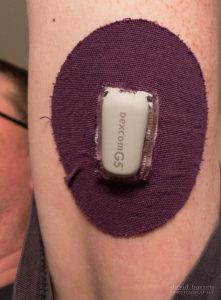
Here you can see the G5 on the back of my upper arm, surrounded by a RockaDex oval patch to help ensure the sensor stays in place for as long as possible. At the time of this photo the RockaDex patch had been in place for almost 7 days.
I got the oval patch to limit the opportunity for corners to start lifting over time, and I did get a range of colours: not just “bruise purple”!
Already I’ve noticed a few things:
Frequency of scanning
Unlike the Libre (which reads glucose data every minute, and passes along all that data whenever it’s scanned) the Dexcom reads glucose data every 5 minutes, transmits that data, and then forgets it. This does allow the transmitter to run for months without running out of battery, but it can easily result in gaps if your collection device missed a transmission (plus having only one transmission every 5 minutes instead of every 1, although the Dexcom does provide a trend arrow at the same time). Luckily these gaps are infrequent for me so far. I’ve configured xDrip+ to use the SW3 watch on my wrist (yes, I’ve been using two watches) as the G5 Bluetooth collection device as well as display, which means that if I walk away from the Android phone the G5 transmissions will still be captured, and transferred to the phone when I get back to it.
Score 1 for the Libre, although the G5 system is quite acceptable.
Gaps in CGM history
As long as there was a Libre sensor active on your arm (even during hours of disconnection) then when you reconnect the scanner the CGM will populate with the missing data (and xDrip+ will upload that to Nightscout/OpenAPS). Using the watch as a G5 collector does minimise these gaps in the history, but they do still occur (and if I take the watch off then there’s no hope of course).

Score 1 for the Libre.
Physical size
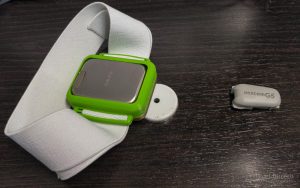 The Dexcom is definitely smaller, and doesn’t have the problem of the Libre scanner occasionally slipping and moving away from the sensor. In those cases I would have to tighten and reposition the armband, after which the Libre would fill in the missing data (and my closed-loop system would come back online by itself). Because no armband is required with the Dexcom, I have the flexibility to position the sensor on locations other than my arm (although I’m very used to using the back of my upper arms where it’s obscured by my sleeve and doesn’t bump into anything, so I’m sticking with that for now).
The Dexcom is definitely smaller, and doesn’t have the problem of the Libre scanner occasionally slipping and moving away from the sensor. In those cases I would have to tighten and reposition the armband, after which the Libre would fill in the missing data (and my closed-loop system would come back online by itself). Because no armband is required with the Dexcom, I have the flexibility to position the sensor on locations other than my arm (although I’m very used to using the back of my upper arms where it’s obscured by my sleeve and doesn’t bump into anything, so I’m sticking with that for now).
Score 1 for the Dexcom.
Shower spikes
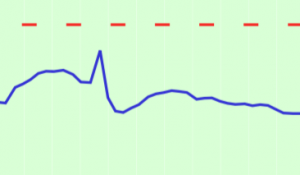 When having a hot shower the Libre readings “spike” up several mmol/l, and then back down again. This seems to be due to the temperature gradient across the sensor (e.g. from the outside to the skin) which affects the way the Libre measures glucose. In fact when I was using RockTape patches around the Libre, after the shower the evaporative cooling from the damp tape induced a downwards spike immediately afterwards, before normal values resumed.
When having a hot shower the Libre readings “spike” up several mmol/l, and then back down again. This seems to be due to the temperature gradient across the sensor (e.g. from the outside to the skin) which affects the way the Libre measures glucose. In fact when I was using RockTape patches around the Libre, after the shower the evaporative cooling from the damp tape induced a downwards spike immediately afterwards, before normal values resumed.
The Abbott Libre Reader device seems to work around this by recognising the anomaly and telling you to try scanning again in 10 minutes, but I got used to just seeing a blip in the data. Incidentally, the same “scan again in 10 minutes” message has been reported by people exposing the Libre to cool air (e.g. runners on a cool day) but mine is usually covered by the SW3 which I guess provides some insulation. Being in cool or hot climates doesn’t seem to affect it, but the rapid change in temperature does.
Before my showers I would take the scanning SW3 and armband off, and the CGM would stop receiving any data. But when I put the armband back on afterwards, within 5 minutes or so the CGM would have downloaded all the missing per-minute data and have resumed normal operation.
The reported (but not real) spike in blood glucose would cause my closed-loop system to pump in a little more insulin for a short while, but it would back off again to compensate as soon as the values dropped, and this blip over 10-15 minutes had no real effect. With a manual pump system it might be easy to mis-correct with too much insulin if you didn’t recognise that it was a false high, but because the closed-loop system is recalculating everything every few minutes and applying smaller corrections through manipulating the pump’s basal rate, it smoothly works around the issue.
With the G5 I take the wristwatch SW3 with me to the bathroom, and leave it beside the sink while I shower. It continues to gather the G5 data without any unusual gaps, and if there is a spike due to sensor temperature variations then it’s a lot smaller than with the Libre.
Score 1 for the Dexcom.
Recharging
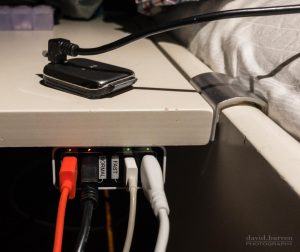 The SW3 that scans the Libre would need recharging every day, although a full charge only takes 30 minutes or so. I have a long USB cable with a flush right-angle connector so it can even be charged from a USB battery in my pocket while still on my arm, but usually I would recharge it at night (or while I was disconnected and having a shower although that’s a lot less than half an hour!).
The SW3 that scans the Libre would need recharging every day, although a full charge only takes 30 minutes or so. I have a long USB cable with a flush right-angle connector so it can even be charged from a USB battery in my pocket while still on my arm, but usually I would recharge it at night (or while I was disconnected and having a shower although that’s a lot less than half an hour!).
The SW3 on my wrist would last longer: usually at least a day and a half. Now with the G5 system the wristwatch is doing a lot more work, and does need recharging every night. But I have one fewer devices to recharge, so score 1 for the Dexcom!
Calibrating
Despite Abbott’s claims that the Libre was self-calibrating, I have found that it does benefit from calibration against finger-prick blood tests. There can be a little variation between sensors, and over the 2-week lifetime of the sensor the reported values can change. In general I found that while BG levels were in a “normal” range the Libre Reader usually gave dependable answers, but it tended to exaggerate both highs and lows.
By occasionally calibrating in xDrip+ when at at variety of levels, I ended up with numbers that would continually be very close to those reported by BG meters (and I have two different models of those if I’m ever doubting the meter). I have more trust in the precision of the values reported by xDrip+ than by the Libre Reader. I would usually try to calibrate at least once per day, but sometimes it would be several days. If I waited too long the calibration would have to make bigger changes to the reported values, so it was always good to not forget. And remembering to calibrate both when high and when low would help a lot too.
With the G5 there’s a need to calibrate at least once per day. From what I’m noticing there’s still a big benefit in calibrating at a variety of levels, which is something I wasn’t told going in. Mind you, with the closed-loop system doing such a good job of managing my levels I don’t always get the chance. I do have to remember to do a finger-prick and re-calibrate if I get into an unusual high-or-low situation: sometimes that’s happened when I wasn’t actually quite so far out of range, but the lack of calibration at those levels had resulted in a mis-reporting and thus false alarm. But that’s not really a bad problem to have, as it’s only resulted in extra alarms.
When calibrating a CGM it’s important to do it when the trend is flat (the levels aren’t changing) as the raw ISF values measured by the CGM sensors will lag a little behind the actual blood glucose. But I must say that when on a closed-loop pump system it’s much easier to find a time when the trend is flat than when on a manually-controlled system!
No advantage between the systems either way on this issue at the moment. Time will tell.
Accuracy
After calibration I have so far noticed no marked difference in accuracy between the Libre and Dexcom systems.
Starting a new sensor
The Libre has been fairly convenient here. The Abbott Libre Reader only allows you to use one sensor at a time, and after you initialise a new sensor you have to wait an hour before getting any values. But because I use a different device to read the sensor I’m able to initialise a new sensor with the Reader while the old one is still working, and after the hour is up I move the scanning device over, tell xDrip+ to reset the calibrations, and remove the old sensor. I end up with no gap in my CGM data (although sometimes a little “blip” as the new calibration settles in).
The G5 forces a 2-hour warm-up period on each new sensor, and I’m not sure of a way to work around this even if I had a spare transmitter. So that’s an occasional big gap in the CGM feed, where the closed-loop system will have no data to work on. It will of course just default back to the normal programmed basal rates in the pump, so all is not lost. But depending on what’s happened in those two hours it may have to play catch-up to bring my levels back to their optimal level.
Score 1 for the Libre at the moment, but more options may come to light.
Price
One of the reasons I started this experiment was that depending on the duration I can get out of each Dexcom sensor, the G5 system may work out cheaper for me than the Libre. But everyone’s expecting new subsidies to appear soon through the Australian NDSS, so time will tell which system comes out ahead on price.
Conclusion
Well, there is no conclusion yet. The G5 system is looking good, while at the same time reminding me of the strengths of the Libre system. I expect more issues may come to light over the life of my current Dexcom sensor and then when I replace the sensor, so again time will tell.

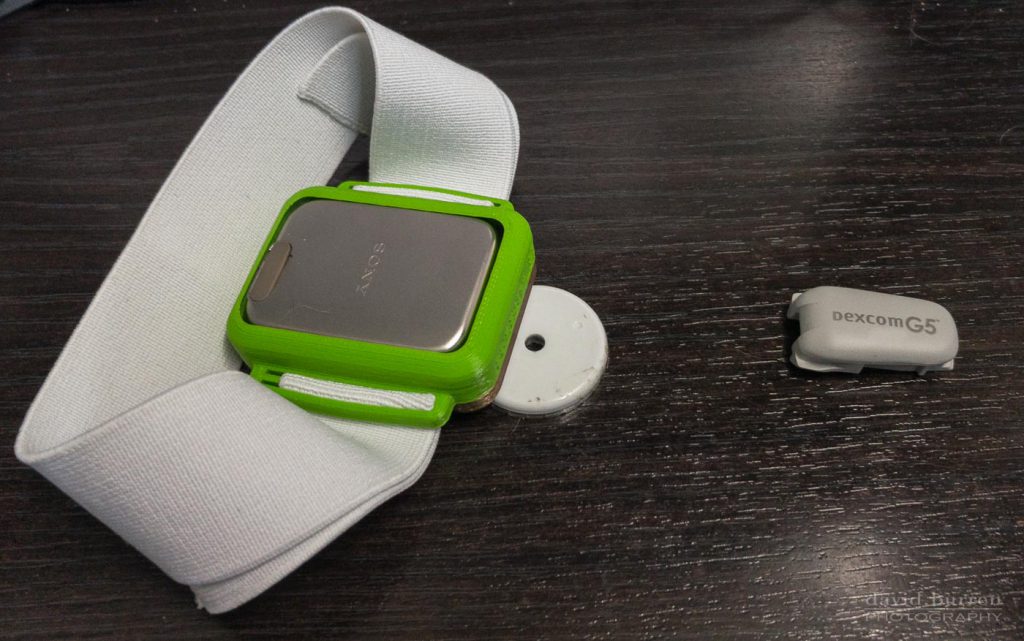
Yes, I am excited to have the Libre tech int he US. But until it links to and is used by a pump, I do not sense it will make it as something I will use.
Yeah, I know two different things. But the CGM is just much more useful.
It does link to and is used by a pump! It’s just that you just have to do the linking yourself at the moment (e.g. with OpenAPS).
On your Dexcom start up time, if you apply the sensor two hours or more prior to starting it in xDrip+, whilst still using the old one, you can take instant readings. When you do switch the sensor over. Many of us do that.
Thanks Tim. That’s in my plan for trying when I start the next sensor.
Thanks for posting this. I started my CGM journey with the Abbott Freestyle Navigator and I was a big fan despite it’s funky calibration rules. I am eagerly awaiting Abbott’s return to the US since for me it was more accurate than Dexcom.
The SW3 is in short supply and hard to obtain. Is there an alternative?
There’s apparently an (expensive) LG watch which will work, but I don’t think it’s suited to being a Libre scanner. There are the Blucon devices (I haven’t used one).
But there are still lots of SW3 on eBay (both new and used).
Thanks for your post. I am wondering how things have transpired since you put that up – do you still think the (calibrated) libre stacks up well against the Dexcom G5 in terms of accuracy?
Yes. I’ve run a few Libre sensors through, comparing side-by-side with G5 (using both a SmartWatch 3 interface and a Blucon Nightrider). The Libre definitely stacks up well, including having less impact from paracetamol/acetaminophen.